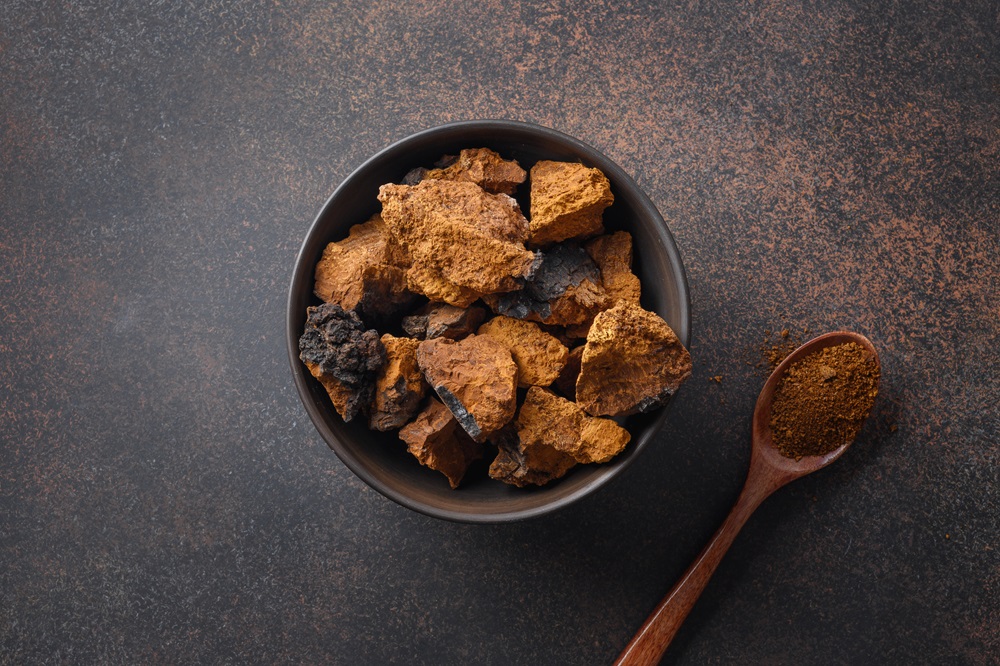Chaga – Effects, Uses, Side Effects

Chaga is a parasitic fungus that grows on deciduous trees and is known for its richness in valuable compounds, which is why it is often called a medicinal or vitality mushroom. It is used in dietary supplements, where it may support the body’s immune system, while also showing antioxidant and anti-inflammatory properties. Chaga - what is it good for? How does the birch conk fungus work? How should it be used?
Table of contents
Chaga - what is it? Understanding the birch conk fungus
Chaga (Inonotus obliquus), also known as birch conk or clinker polypore, is a species of parasitic fungus from the Hymenochaetaceae family. It grows on deciduous trees, most commonly on birches. It attacks weakened parts of trees, leading to disease and forming distinctive, irregular black growths that look like dark lumps of soil attached to the bark.
Chaga has been used for centuries by the people of Russia and Siberia, but it can also be found in other parts of Asia, as well as in North America and Europe. In Poland, birch conk is rare, which is why it appears on the Red List of Plants and Fungi of Poland and is under partial protection.
This fungus can be found both in forests and parks or on single standing trees. It is visible year-round, but easiest to spot when trees are without leaves.
Chaga - composition
The health-promoting potential of chaga comes from the compounds present in its fruiting bodies. Scientific research shows that it contains:
- polysaccharides, such as beta-glucans
- steroid compounds
- phospholipids
- phenolic compounds, such as flavonoids
- unsaturated fatty acids
- triterpenoids
- dietary fiber
- hemicellulose
- ubiquinone
- vitamins, including vitamin K and B vitamins
- minerals such as zinc and potassium
Because of this, chaga is considered a medicinal mushroom, which, according to historical records, was already used in Poland in the 5th century AD and remained popular in the Middle Ages.
Chaga - properties. How does birch conk work?
Studies suggest that chaga may have antioxidant properties, acting as a source of antioxidants. It may neutralize free radicals and reactive oxygen species, reduce oxidative stress, and slow the aging process. It may also positively affect the immune system by stimulating the production of white blood cells and fighting harmful microorganisms.
Additionally, chaga may have anti-inflammatory potential, reducing inflammation and inhibiting the production of pro-inflammatory cytokines. It may also have antiviral effects and influence immune cells responsible for allergic reactions to certain foods, thus reducing food allergy symptoms.
Preliminary research indicates that chaga extract may benefit the cardiovascular system by influencing cholesterol levels - helping lower total cholesterol, LDL cholesterol, and triglycerides, while increasing HDL cholesterol, known as the “good” cholesterol.
It is also believed that chaga may have anti-hyperglycemic properties, improving glucose-insulin balance. Studies indicate it may help lower blood sugar levels and reduce insulin resistance. Furthermore, chaga could support digestive health by helping combat stomach and duodenal ulcers.
Although these potential benefits are promising, most scientific studies to date have been conducted on animals or in vitro. More human-based research is needed to confirm the effects of chaga on human health.
Birch conk fungus - uses
Chaga can be used in various ways. It can be made into tinctures, infusions, and decoctions. It is sometimes used as a tea substitute and as an ingredient in antibacterial soap. Increasingly, it is also being added to coffee or drinking chocolate, and there are cosmetics available on the market containing chaga extract.
Dietary supplements with chaga are also becoming more popular. They are available in various forms, including powders and capsules.
Chaga supplements - which one to choose?
You can find single-ingredient products containing only chaga extract, as well as complex supplements that combine it with other medicinal mushrooms, such as lion’s mane or cordyceps. The choice depends on individual needs and preferences.
When looking for a high-quality chaga product, check for standardization. The best products contain extracts standardized for key compounds such as polysaccharides and triterpenes and display a DER (Drug Extract Ratio) value, showing the ratio of raw material used to the amount of final product obtained.
How to take chaga?
In scientific research, chaga is usually used in doses of 500-1500 mg of extract. Because there is still limited human research, there is no universal recommendation for the ideal daily dose.
Some guidelines suggest taking chaga once a day with a meal, while others recommend consuming it three times a day - morning, afternoon, and evening. It is best to follow the instructions provided by the supplement manufacturer.
Since chaga does not have immediate effects, regular use for about 4-6 weeks is advised to see potential benefits.
Chaga - side effects
When used in moderate amounts according to the manufacturer’s recommendations, chaga should not cause adverse effects. However, due to its oxalate content, excessive intake could contribute to kidney stones and kidney damage. Some individuals may experience digestive discomfort, such as nausea, stomach pain, diarrhea, or heartburn. To avoid issues, do not exceed the recommended dose.
Chaga - contraindications
Chaga should not be used by people taking immunosuppressive or anti-diabetic medications, as it may interact with these drugs, affecting blood sugar regulation and having anticoagulant effects.
Research suggests that chaga may inhibit platelet aggregation and increase bleeding risk. Therefore, it is not recommended to take chaga before planned surgeries or medical procedures.

